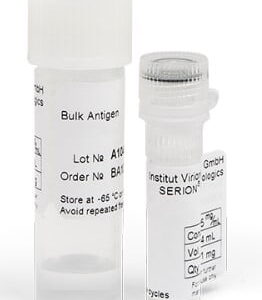| Weight | 1 lbs |
|---|---|
| Dimensions | 9 × 5 × 2 in |
| target | Varicella Zoster Virus (VZV) Envelope Glycoprotein E |
| species reactivity | Varicella-Zoster Virus |
| applications | ELISA |
| assay type | Indirect & quantitative |
| available size | 1 mg |
Varicella Zoster Virus (VZV) Envelope Glycoprotein E Control Antigen BA104R02
$887.00
Summary
- Virion/Serion Diagnostic Kit Control for research use (RUO)
- Varicella Zoster Virus (VZV) Envelope Glycoprotein E Control Antigen, recombinant
- Suitable for detection of IgA, IgG & IgM antibodies in ELISA
- Lot specific concentration, specified in mg/mL
- 1 mg
Varicella Zoster Virus (VZV) Envelope Glycoprotein E Control Antigen BA104R02
| kit |
|---|
| Research area Infectious Disease |
| Storage Store at -65°C. Avoid freeze/thaw cycles. Sonicate before use. |
| Form liquid |
| Associated products Varicella-Zoster Virus Antigen (BA104VS) Varicella-Zoster Virus Glycoprotein Antigen (BA104VSG) Varicella-Zoster Virus IgA Control Serum (BC104A) Varicella-Zoster Virus IgG Control Serum (BC104G) Varicella-Zoster Virus IgM Control Serum (BC104M) Varicella-Zoster Virus IgA ELISA Kit (ESR104A) Varicella-Zoster Virus IgG ELISA Kit (ESR104G) Varicella-Zoster Virus IgM ELISA Kit (ESR104M) |
| target relevance |
|---|
| Organism Varicella-Zoster Virus |
| Protein names Varicella-ZosterVirus |
| Structure and strains Varicella zoster virus (VZV), also known as human herpesvirus 3 (HHV-3, HHV3) or Human alphaherpesvirus 3 (taxonomically), is one of nine known herpes viruses that can infect humans. It causes chickenpox (varicella) commonly affecting children and young adults, and shingles (herpes zoster) in adults but rarely in children. VZV infections are species-specific to humans. The virus can survive in external environments for a few hours. VZV multiplies in the tonsils, and causes a wide variety of symptoms. Similar to the herpes simplex viruses, after primary infection with VZV (chickenpox), the virus lies dormant in neurons, including the cranial nerve ganglia, dorsal root ganglia, and autonomic ganglia. Many years after the person has recovered from initial chickenpox infection, VZV can reactivate to cause shingles. |
| Detection and diagnosis IgG as well as IgM and, in most cases, also IgA antibodies are produced within a few days following the regular course of a primary infection with VZV. In cases of Herpes zoster, IgG and IgA concentrations rise rapidly within a few days of disease onset. In most cases, IgM antibody activity is also detectable once more |
Data
Publications
| pmid | title | authors | citation |
|---|---|---|---|
| We haven't added any publications to our database yet. | |||
Protocols
| relevant to this product |
|---|
| BA104R02 protocol |
Documents
| Product data sheet |
|---|
| BA104R02 |
Only logged in customers who have purchased this product may leave a review.















Reviews
There are no reviews yet.